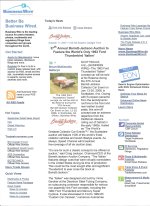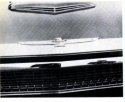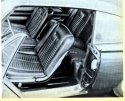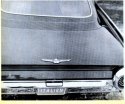 The RAREST THUNDERBIRD EVER BUILT ONE OF A KIND... THE ONLY ONE IN EXISTENCE... THE ONLY ONE EVER BUILT!!! THE 1963 FORD THUNDERBIRD ITALIEN CONCEPT CAR
| ||
 1963 ITALIEN  PRESS FOTO  PRESS FOTO  PRESS FOTO  11-15-05  11-15-05  11-15-05 |
By chance, this lucky car happened to roll off the assembly line at the time the Ford Styling Design team was exploring building a fastback thunderbird. The design team took the car into their shop and removed the production roof system and deck and built a roof buck from plywood. Although Ford designed the car, at this point we believe they delivered or sold the car to Dearborn Steel Tubing where the actual modifications were done. You may remember that DST did the body and performance modifications on the 100 Thunderbolts that were built. It was sometime later in the Italiens finishing stages that Ford delivered the '63 Fenders and doors to DST for installation on the car because by the time DST was nearing completion of the ITALIEN, The 1963 model year Thunderbirds were in production and Ford didn't want a 1962 model concept/show car touring with the Custom Car Caravan. After a very successful tour in Fords first of three "Custom
Car Caravan" Car shows, in conjunction with the "ISCA"(International
Show Car Association), unlike most Ford concept cars, The Italien
escaped the crusher and was given or sold to Dale Robertson who starred
in TV Westerns such as "Tales of Wells Fargo", Wagon Train" and others.
It is rumored that Dale had a part in the design of the Italien. He allegedly wanted Ford to build him a unique car and accepted the Italien because it was in the design/construction stage at the time. He made 6-8 trips to Ford to consult in some finishing details of the car. Mr. Robertson eventually gave the car to his gardener who painted it the Silver Mink color it is today. In the mid 1980's, the noted Ford Collector Don Chambers of Paramount California purchased the car. Don tells me he brought the car to the well known Restorer Mike Fennell who restores cars for the Imperial Palace Car Museum in Las Vegas. Mike has his shop in Northern California. He left the car there for several days so that Mike could assess the work that would be needed and give Don a ball park estimate of the cost to restore the Italien. Don was anticipating investing $60,000.00-$65,000.00 in the restoration. Don says that for some reason when he contacted Mike to talk to him about his assessment, Mike was acting very "fishy" and "elusive" and wouldn't discuss the car. Don then returned to get the car and found that Mike had dissassembled some of the parts. He loaded it back on his trailer and brought it back home and put it back in his storage garage where it sat until I found it. The parts removed by Mike had still not been reinstalled and that's why the pictures don't have the back bumper in place. Here's where I enter the picture...Page 2 Here's how they did it |
|
                     |
Ford Styling
built a wooden and clay mock up over a stock T-bird
ragtop. This photo shows the car with it's '62 style fenders and doors.
|
|